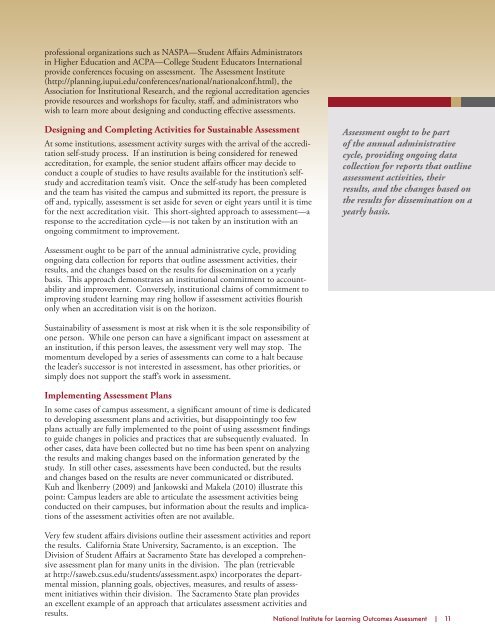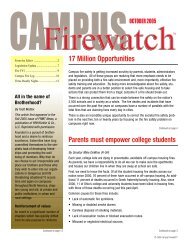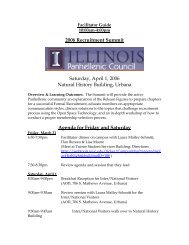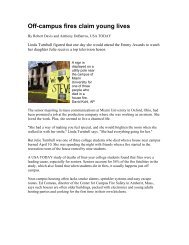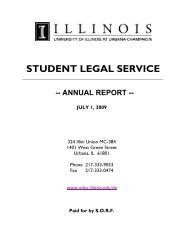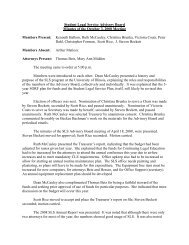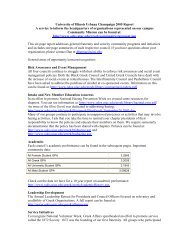StudentAffairsRole in Assessment - Office of the Dean of Students ...
StudentAffairsRole in Assessment - Office of the Dean of Students ...
StudentAffairsRole in Assessment - Office of the Dean of Students ...
You also want an ePaper? Increase the reach of your titles
YUMPU automatically turns print PDFs into web optimized ePapers that Google loves.
pr<strong>of</strong>essional organizations such as NASPA—Student Affairs Adm<strong>in</strong>istrators<br />
<strong>in</strong> Higher Education and ACPA—College Student Educators International<br />
provide conferences focus<strong>in</strong>g on assessment. The <strong>Assessment</strong> Institute<br />
(http://plann<strong>in</strong>g.iupui.edu/conferences/national/nationalconf.html), <strong>the</strong><br />
Association for Institutional Research, and <strong>the</strong> regional accreditation agencies<br />
provide resources and workshops for faculty, staff, and adm<strong>in</strong>istrators who<br />
wish to learn more about design<strong>in</strong>g and conduct<strong>in</strong>g effective assessments.<br />
Design<strong>in</strong>g and Complet<strong>in</strong>g Activities for Susta<strong>in</strong>able <strong>Assessment</strong><br />
At some <strong>in</strong>stitutions, assessment activity surges with <strong>the</strong> arrival <strong>of</strong> <strong>the</strong> accreditation<br />
self-study process. If an <strong>in</strong>stitution is be<strong>in</strong>g considered for renewed<br />
accreditation, for example, <strong>the</strong> senior student affairs <strong>of</strong>ficer may decide to<br />
conduct a couple <strong>of</strong> studies to have results available for <strong>the</strong> <strong>in</strong>stitution’s selfstudy<br />
and accreditation team’s visit. Once <strong>the</strong> self-study has been completed<br />
and <strong>the</strong> team has visited <strong>the</strong> campus and submitted its report, <strong>the</strong> pressure is<br />
<strong>of</strong>f and, typically, assessment is set aside for seven or eight years until it is time<br />
for <strong>the</strong> next accreditation visit. This short-sighted approach to assessment—a<br />
response to <strong>the</strong> accreditation cycle—is not taken by an <strong>in</strong>stitution with an<br />
ongo<strong>in</strong>g commitment to improvement.<br />
<strong>Assessment</strong> ought to be part<br />
<strong>of</strong> <strong>the</strong> annual adm<strong>in</strong>istrative<br />
cycle, provid<strong>in</strong>g ongo<strong>in</strong>g data<br />
collection for reports that outl<strong>in</strong>e<br />
assessment activities, <strong>the</strong>ir<br />
results, and <strong>the</strong> changes based on<br />
<strong>the</strong> results for dissem<strong>in</strong>ation on a<br />
yearly basis.<br />
<strong>Assessment</strong> ought to be part <strong>of</strong> <strong>the</strong> annual adm<strong>in</strong>istrative cycle, provid<strong>in</strong>g<br />
ongo<strong>in</strong>g data collection for reports that outl<strong>in</strong>e assessment activities, <strong>the</strong>ir<br />
results, and <strong>the</strong> changes based on <strong>the</strong> results for dissem<strong>in</strong>ation on a yearly<br />
basis. This approach demonstrates an <strong>in</strong>stitutional commitment to accountability<br />
and improvement. Conversely, <strong>in</strong>stitutional claims <strong>of</strong> commitment to<br />
improv<strong>in</strong>g student learn<strong>in</strong>g may r<strong>in</strong>g hollow if assessment activities flourish<br />
only when an accreditation visit is on <strong>the</strong> horizon.<br />
Susta<strong>in</strong>ability <strong>of</strong> assessment is most at risk when it is <strong>the</strong> sole responsibility <strong>of</strong><br />
one person. While one person can have a significant impact on assessment at<br />
an <strong>in</strong>stitution, if this person leaves, <strong>the</strong> assessment very well may stop. The<br />
momentum developed by a series <strong>of</strong> assessments can come to a halt because<br />
<strong>the</strong> leader’s successor is not <strong>in</strong>terested <strong>in</strong> assessment, has o<strong>the</strong>r priorities, or<br />
simply does not support <strong>the</strong> staff’s work <strong>in</strong> assessment.<br />
Implement<strong>in</strong>g <strong>Assessment</strong> Plans<br />
In some cases <strong>of</strong> campus assessment, a significant amount <strong>of</strong> time is dedicated<br />
to develop<strong>in</strong>g assessment plans and activities, but disappo<strong>in</strong>t<strong>in</strong>gly too few<br />
plans actually are fully implemented to <strong>the</strong> po<strong>in</strong>t <strong>of</strong> us<strong>in</strong>g assessment f<strong>in</strong>d<strong>in</strong>gs<br />
to guide changes <strong>in</strong> policies and practices that are subsequently evaluated. In<br />
o<strong>the</strong>r cases, data have been collected but no time has been spent on analyz<strong>in</strong>g<br />
<strong>the</strong> results and mak<strong>in</strong>g changes based on <strong>the</strong> <strong>in</strong>formation generated by <strong>the</strong><br />
study. In still o<strong>the</strong>r cases, assessments have been conducted, but <strong>the</strong> results<br />
and changes based on <strong>the</strong> results are never communicated or distributed.<br />
Kuh and Ikenberry (2009) and Jankowski and Makela (2010) illustrate this<br />
po<strong>in</strong>t: Campus leaders are able to articulate <strong>the</strong> assessment activities be<strong>in</strong>g<br />
conducted on <strong>the</strong>ir campuses, but <strong>in</strong>formation about <strong>the</strong> results and implications<br />
<strong>of</strong> <strong>the</strong> assessment activities <strong>of</strong>ten are not available.<br />
Very few student affairs divisions outl<strong>in</strong>e <strong>the</strong>ir assessment activities and report<br />
<strong>the</strong> results. California State University, Sacramento, is an exception. The<br />
Division <strong>of</strong> Student Affairs at Sacramento State has developed a comprehensive<br />
assessment plan for many units <strong>in</strong> <strong>the</strong> division. The plan (retrievable<br />
at http://saweb.csus.edu/students/assessment.aspx) <strong>in</strong>corporates <strong>the</strong> departmental<br />
mission, plann<strong>in</strong>g goals, objectives, measures, and results <strong>of</strong> assessment<br />
<strong>in</strong>itiatives with<strong>in</strong> <strong>the</strong>ir division. The Sacramento State plan provides<br />
an excellent example <strong>of</strong> an approach that articulates assessment activities and<br />
results.<br />
National Institute for Learn<strong>in</strong>g Outcomes <strong>Assessment</strong> | 11


